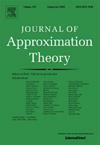比较有约束和无约束三角逼近的程度
IF 0.6
3区 数学
Q2 MATHEMATICS
引用次数: 0
摘要
让r, s∈N。对于一个连续的2π周期函数,在一个周期内单调变化2s次,且阶为<;n的三角多项式的逼近度≤n−r, n≥1,我们研究了其单调变化的多项式的逼近度。显然,不受约束的程度小于受约束的程度,但对于r>;2s−2,存在一个常数c(s,r),使得受约束程度≤c(s,r)n−r, n≥1。另一方面,我们证明,一般来说,这对于r≤2s−2是无效的。本文章由计算机程序翻译,如有差异,请以英文原文为准。
Comparing the degree of constrained and unconstrained trigonometric approximation
Let . For a continuous -periodic function, changing its monotonicity times in a period, and whose degree of approximation by trigonometric polynomials of degree , is , , we investigate its degree of approximation by such polynomials that, in addition, follow the changes of monotonicity. Obviously, the unconstrained degree is smaller than the constrained one, but for , there is a constant such that the constrained degree is , . On the other hand we show that, in general, this is invalid for .
求助全文
通过发布文献求助,成功后即可免费获取论文全文。
去求助
来源期刊
CiteScore
1.90
自引率
11.10%
发文量
55
审稿时长
6-12 weeks
期刊介绍:
The Journal of Approximation Theory is devoted to advances in pure and applied approximation theory and related areas. These areas include, among others:
• Classical approximation
• Abstract approximation
• Constructive approximation
• Degree of approximation
• Fourier expansions
• Interpolation of operators
• General orthogonal systems
• Interpolation and quadratures
• Multivariate approximation
• Orthogonal polynomials
• Padé approximation
• Rational approximation
• Spline functions of one and several variables
• Approximation by radial basis functions in Euclidean spaces, on spheres, and on more general manifolds
• Special functions with strong connections to classical harmonic analysis, orthogonal polynomial, and approximation theory (as opposed to combinatorics, number theory, representation theory, generating functions, formal theory, and so forth)
• Approximation theoretic aspects of real or complex function theory, function theory, difference or differential equations, function spaces, or harmonic analysis
• Wavelet Theory and its applications in signal and image processing, and in differential equations with special emphasis on connections between wavelet theory and elements of approximation theory (such as approximation orders, Besov and Sobolev spaces, and so forth)
• Gabor (Weyl-Heisenberg) expansions and sampling theory.

 求助内容:
求助内容: 应助结果提醒方式:
应助结果提醒方式:


